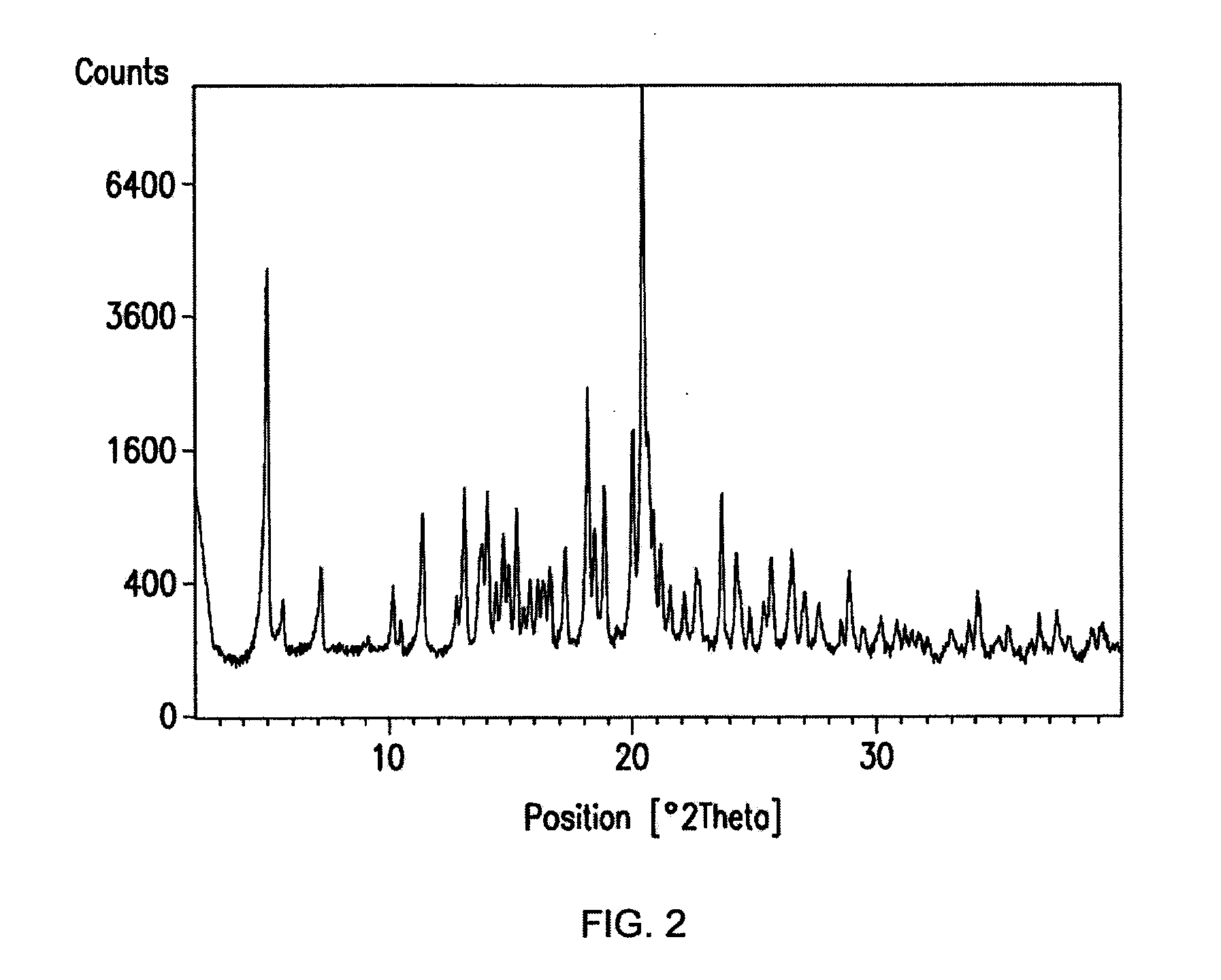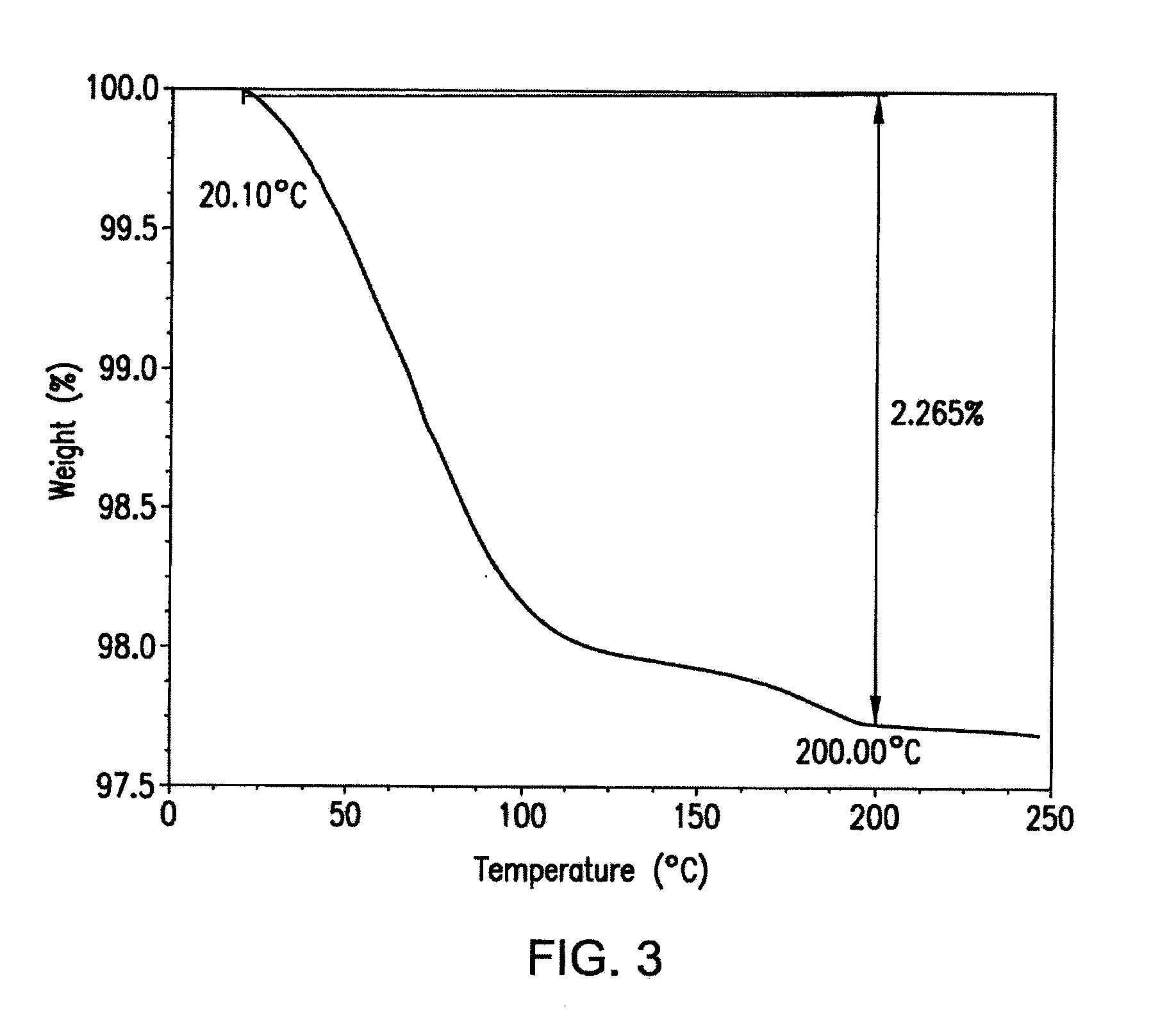Crystal forms of a hcv protease inhibitor
a protease inhibitor and crystal form technology, applied in the field of different forms of hcv protease inhibitors, can solve the problems of major health problems of hcv infection
- Summary
- Abstract
- Description
- Claims
- Application Information
AI Technical Summary
Benefits of technology
Problems solved by technology
Method used
Image
Examples
example 1
Preparation of 2-[2-(3-Chloro-propyl)-cyclopropyl]-4,4,5,5-tetramethyl-[1,3,2]dioxaborolane (Compound 3)
[0120]
[0121]Compound 2 can be prepared as described by Shirakawa et al. Synthesis 11:1814-1820, 2004.)
[0122]Compound 3 was produced as follows: To a 5 L flask equipped with a nitrogen inlet, mechanical stirrer, dropping funnel and thermocouple under N2 was added 800 mL dichloromethane and 800 mL of a 1 M diethylzinc solution in heptane (0.8 mol, 1.07 equiv). The solution was cooled with an ice bath to an internal temperature of 3° C. To the flask was then added from the dropping funnel a solution of 57.6 mL trifluoroacetic acid (0.748 mol, 1.0 equiv) in 200 mL dichloromethane over 1 hour, keeping the internal temperature below 10° C. The resulting suspension was stirred for 30 min at 3° C. To the flask was then added 72.4 mL diiodomethane (0.897 mol, 1.2 equiv) in a single portion. After stirring at 3° C. for 30 min, 172 mL of 2 (0.748 mol, 1.0 equiv) was added to the solution in ...
example 2
Preparation of 2-(3-Chloro-propyl)-cyclopropanol (Compound 4)
[0123]
[0124]To a 3 L flask equipped with a nitrogen inlet, mechanical stirrer, dropping funnel and thermocouple was added 143 g of 3 (0.585 mol, 1.0 equiv) in 1 L methanol. To the flask was then added from the dropping funnel 58.5 mL of 10 M sodium hydroxide (0.585 mol, 1.0 equiv) over 30 min, while the internal temperature was maintained below 10° C. with external cooling. After stirring for 30 min, 120 mL of 30 wt % hydrogen peroxide solution (1.17 mol, 2 equiv) was slowly added from the dropping funnel over 1 hour, keeping the internal temperature below 10° C. Upon completion of the addition, the resulting colorless slurry was then stirred at ambient temperature for 30 min or until complete consumption of 3 was observed by GC. 2 M HCl (375 mL) was added from the dropping funnel over 30 min, keeping the internal temperature below 10° C. To this clear yellow solution was then slowly added 500 mL of a 1 M solution of Na2SO...
example 3
Preparation of 2-Pent-4-ynyl-cyclopropanol (rac-Compound 5)
[0125]
[0126]To a 2-neck 15-mL flask equipped with a temperature probe, N2 inlet, and septum was added 1 g of 4 (7.28 mmol, 1.0 equiv) and 3.0 mL THF. The solution was cooled to an internal temperature of 0° C. with an ice bath. To this solution was added 2.95 mL of 33 wt % n-Hexyllithium (7.28 mmol, 1.0 equiv) slowly via syringe pump over 1 hour. Internal temperature rose to 6.8° C. and solution became yellow. In a separate 3-neck 100-mL flask equipped with a temperature probe, N2 inlet, and septum 0.82 g of lithium acetylide-ethylenediamine complex (8.01 mmol, 1.1 equiv) was slurried in 5.0 mL of DMPU at room temperature. To this room temperature slurry, the cold solution of the deprotonated cyclopropanol was transferred via cannula over 5 min. After the addition, the brown mixture was heated to an internal temperature of 52° C. with a heating mantle for 3 hours or until greater than 98% conversion was observed by GC. The b...
PUM
| Property | Measurement | Unit |
|---|---|---|
| pH | aaaaa | aaaaa |
| volume | aaaaa | aaaaa |
| 2Θ | aaaaa | aaaaa |
Abstract
Description
Claims
Application Information
 Login to View More
Login to View More - R&D
- Intellectual Property
- Life Sciences
- Materials
- Tech Scout
- Unparalleled Data Quality
- Higher Quality Content
- 60% Fewer Hallucinations
Browse by: Latest US Patents, China's latest patents, Technical Efficacy Thesaurus, Application Domain, Technology Topic, Popular Technical Reports.
© 2025 PatSnap. All rights reserved.Legal|Privacy policy|Modern Slavery Act Transparency Statement|Sitemap|About US| Contact US: help@patsnap.com



